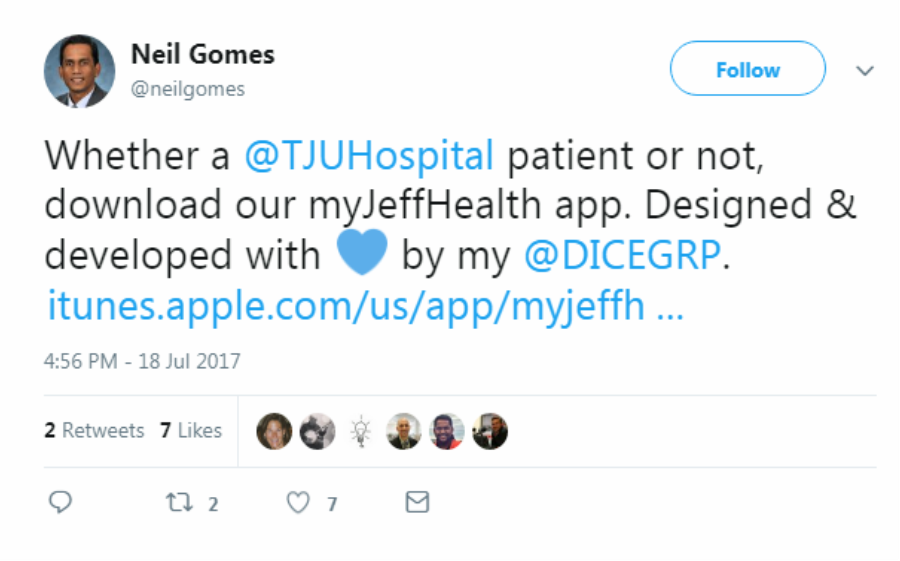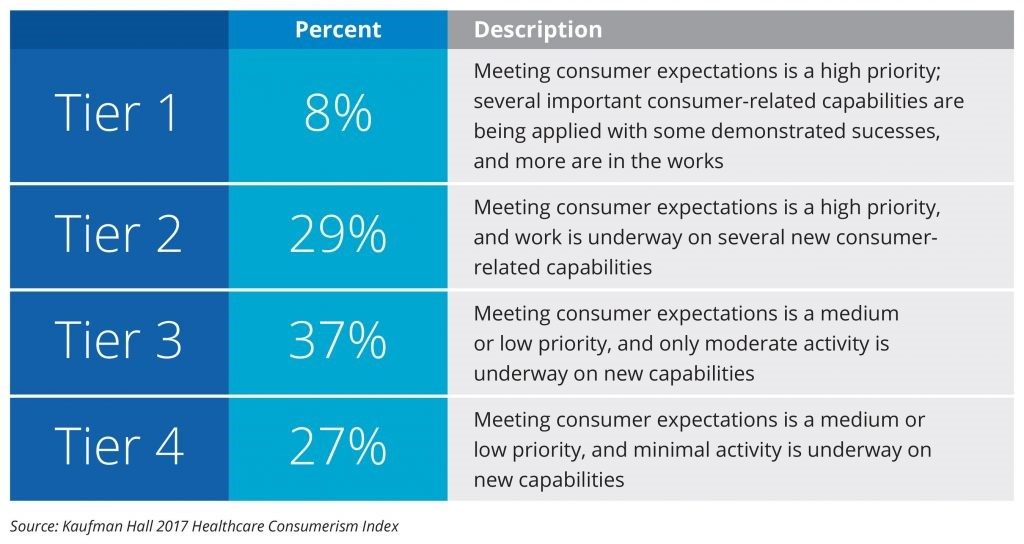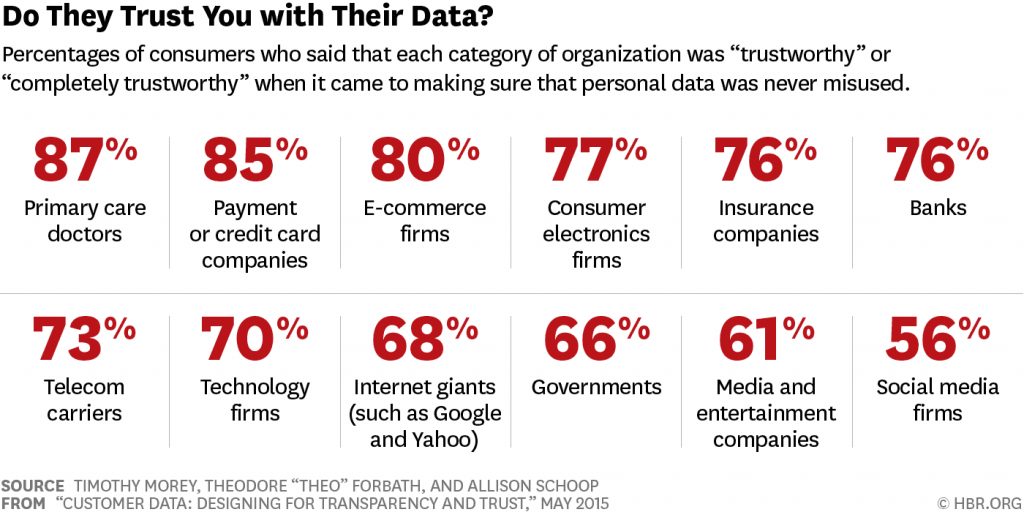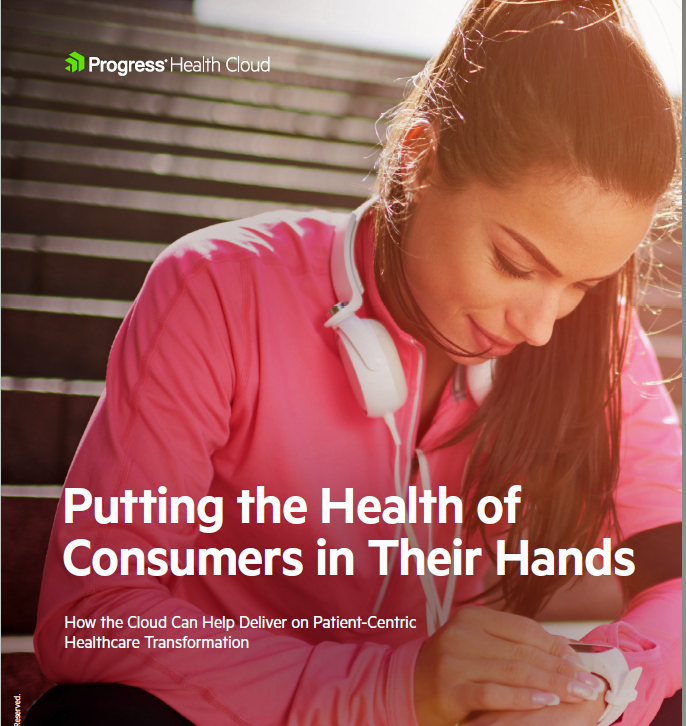On July 18, 2017, Neil Gomes, Chief Digital Officer at Thomas Jefferson University and Jefferson Health in Philadelphia, tweeted this:
 When I saw this tweet, I was especially struck by Gomes’s phrase, “Designed & developed with heart/love by my @DICEGRP.” That’s Jefferson’s health solutions group that focuses on digital innovation and consumer experience.
When I saw this tweet, I was especially struck by Gomes’s phrase, “Designed & developed with heart/love by my @DICEGRP.” That’s Jefferson’s health solutions group that focuses on digital innovation and consumer experience.
Here’s a health system that’s focused on that customer experience, which has become a critical success factor for healthcare to thrive. That’s because, as Steve Laughlin, VP and General Manager of IBM’s Global Consumer Group recently explained to me, a consumer’s last great customer experience becomes the benchmark expectation for the next one.
This translates to consumers’ growing expectations of the healthcare industry…including hospitals.
Hospitals are falling short of consumers’ experience-expectations, Kaufman Hall explained in their 2017 State of Consumerism in Healthcare Report with the apt sub-title, “Slow Progress in Fast Times.”
9 in 10 hospitals and health systems prioritize improving the consumer/patient experience, but only 30% of providers are building these capabilities, I wrote in the Health Populi blog discussing Kaufman Hall’s research.
 Digital health innovations will play big roles in supporting that consumer health experience for most health providers: 58% prioritize offering digital tool and information for consumer engagement, and 56% of providers look to develop a range of virtual/telehealth access points.
Digital health innovations will play big roles in supporting that consumer health experience for most health providers: 58% prioritize offering digital tool and information for consumer engagement, and 56% of providers look to develop a range of virtual/telehealth access points.
But it appears that while healthcare providers’ spirits are willing, their flesh (that is, actions) are weak.
Jefferson Health System would fall into Tier 1 in Kaufman Hall’s segmentation because they’ve prioritized meeting consumer expectations of top strategic importance. I featured Neil’s and the @DICEGRP team’s work in my paper written for Progress Health Cloud, Putting the Health of Consumers in Their Hands.
The sort of digital experiences consumers have in their everyday lives streamlining life-flows using OpenTable for reserving restaurant tables, Lyft for grabbing rides, Airbnb for finding a place to stay, and Waze for routing a fast-trip. In each case, consumers feel empowerment through the experience, quickly accomplishing an important task that enhances their lives in the moment.
Amazon has set the ultimate bar, for now, via both its ecommerce portal and Prime program which ships goods to people within hours or a couple of days of clicking, “order.” With the company’s entry into some aspects of healthcare, from over-the-counter medicines to materials management for clinic supply-chains.
Thus, health consumers have been, as I recently coined, “Amazon Primed.”
Health care providers can address that demand-side of consumers clamoring for retail-style service in health care by taking stock of their patients’, consumers’, and caregivers’ needs that can be addressed through the development of digital tools with enchanting UX-design baked in.
Enter the enterprise health cloud (EHC).
Health clouds yield many benefits to hospitals looking to address the digital service chasms between providers and patients/consumers. EHCs can:
- Simplify interoperability, enabling data to move into applications
- Enable providers to deliver engagement consumer experiences leveraging pre-built application services
- Free developers to focus all their energies on developing an app and that brilliant consumer/UX, not deal with infrastructure of middleware
- Lower risk and cost of app delivery conserving scarce IT labor for their highest-and-best-use
- Streamline development and help hospitals get new apps into patients’ hands.
These benefits can’t be realized in healthcare without the enterprise health cloud ensuring privacy and security. Mobile apps do pose challenges for protecting digitized personal health information (PHI). With the alarming growth of cyber-threats in healthcare, it’s key for an enterprise health cloud to address security rules, safeguards and specs required by HIPAA. Most consumers deem healthcare providers to be good data stewards, researchers from frog, the designer consultancy, found.
 Ultimately, the Jefferson Health team chose to work with the HIPAA-compliant Progress Health Cloud to develop a portfolio of apps, leveraging the platform and realizing the benefits of streamlining app development, enhancing staff creativity and morale, and ultimately fast-tracking delightful tools to patients’ and clinicians’ hands.
Ultimately, the Jefferson Health team chose to work with the HIPAA-compliant Progress Health Cloud to develop a portfolio of apps, leveraging the platform and realizing the benefits of streamlining app development, enhancing staff creativity and morale, and ultimately fast-tracking delightful tools to patients’ and clinicians’ hands.
Coming full-circle to Neil’s tweet, about developing health IT with Heart, I remind everyone attending #HIMSS18 the mantra initially coined by Tim Sanders, a Yahoo! pioneer, that #LoveIsTheKillerApp. That’s really a core value bridging health care providers and patients to boost the most effective engagement, shared decision-making, and trust.
Note for HIMSS18 attendees: The Jefferson Health team will be presenting at #HIMSS18, and I’m looking forward to hearing their updates on the Digital Command Center for EHR Implementation at 4 pm on Wednesday, March 7 (Session #190).
This post has been published on Progress Software’s website here.





 I am so grateful to Tom Lawry for asking me to pen the foreword for his book, Health Care Nation,
I am so grateful to Tom Lawry for asking me to pen the foreword for his book, Health Care Nation,  I love sharing perspectives on what's shaping the future of health care, and appreciate the opportunity to be collaborating once again with Duke Corporate Education and a global client on 6th May. We'll be addressing some key pillars to consider in scenario planning such as growing consumerism in health care, technology (from AI to telehealth), climate change, and trust -- the key enabler for health engagement or dis-engagement and mis-information. I'm grateful to be affiliated with the corporate education provider
I love sharing perspectives on what's shaping the future of health care, and appreciate the opportunity to be collaborating once again with Duke Corporate Education and a global client on 6th May. We'll be addressing some key pillars to consider in scenario planning such as growing consumerism in health care, technology (from AI to telehealth), climate change, and trust -- the key enabler for health engagement or dis-engagement and mis-information. I'm grateful to be affiliated with the corporate education provider  Thank you FeedSpot for
Thank you FeedSpot for